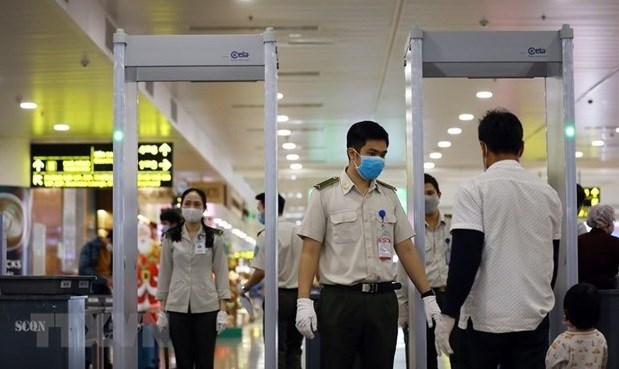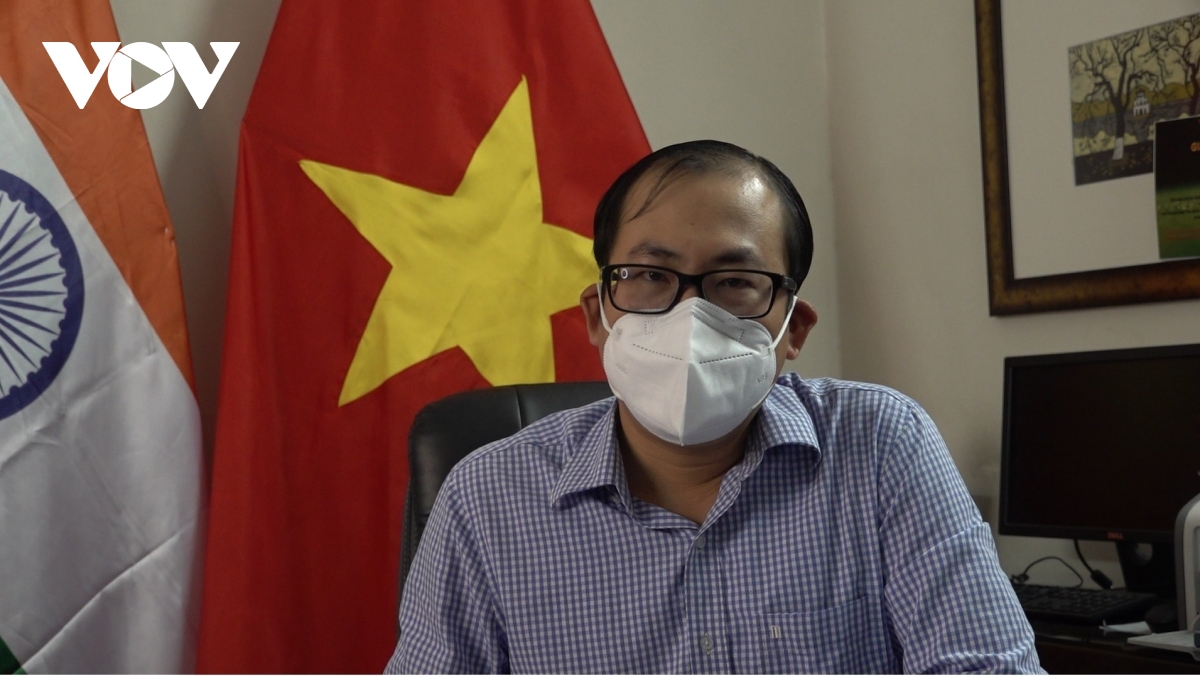
Security screening at an airport in Vietnam (Photo: VNA)
According to Vietnam News Agency, security measures will be enhanced at all units in the sector, including airport authorities, airports, aviation service providers and air traffic service suppliers.
They are asked to increase personnel for aviation security control, examine and supplement necessary equipment, while preparing measures to improve service quality which helps meet travel demand of people.
Under current regulations, when there are high risks to aviation security, security control measures can be tightened in three levels.
Level 1 is applied in case of nationally important socio-political events, or complicated situations of political security and social order.
Level 2 is applied when there is intelligence information about an illegal interference plot in civil aviation activities with places, targets and time undetermined; or in case of serious political insecurity and social disorder in localities.
Meanwhile, level 3 is applied when there is verified information about an illegal interference plot in civil aviation activities with specific places, targets and time; or in case of extremely serious political insecurity and social disorder in localities.
Travel demand during public holiday is expected to increase significantly.
According to a survey conducted by the Vietnam Tourism Advisory Board and VnExpress.net in March, of 3,500 respondents, 53.4 percent had plans to travel between May and September while 30.2 percent said they were ready to go on holidays in March and April.
The top 10 getaways are Da Nang, Kien Giang, Lam Dong, Lao Cai, Khanh Hoa, Quang Ninh, Binh Dinh, Binh Thuan, Ha Giang, and Quang Nam, the survey revealed.
Meanwhile, travel firms said that up to 60 percent of tours have been booked for the four-day holidays. Tourists are booking mostly short-distance trips and brief stays in Sa Pa, Ha Long, Phu Quoc, Da Nang, Da Lat, and Con Dao Island.
Vietravel said that around 60 percent of its vacation packages, which include flights, car rentals, and hotels, have been bought.
Tan Son Nhat Airport in Ho Chi Minh City recently has seen many groups of tourists checking in for flights to Hanoi, Phu Quoc, Da Nang and provinces in the northeastern and northwestern region./.
CPTPP paves way for local goods to penetrate the Americas
Two years after being implemented, the Comprehensive and Progressive Agreement for Trans-Pacific Partnership (CPTPP) has become a driving force, paving the way for Vietnamese products to make greater inroads into countries in North, Central, and South America, according to industry insiders, reported VOV.

The seminar (Source: VOV)
Experts share their viewpoints on opportunities to boost Vietnam's exports to American markets
The view was shared by Deputy Minister of Industry and Trade Do Thang Hai during a seminar in Hanoi on April 27 aimed at discussing various opportunities to boost Vietnamese exports to the Americas.
Hai emphasised that despite the adverse impact caused by the COVID-19 pandemic last year, Vietnamese export turnover to the Americas achieved plenty of encouraging results and has become a bright spot in terms of trade exchanges between Vietnam and other countries globally.
The total import-export turnover between the two sides last year surged by 16% to roughly US$111.5 billion compared to 2019. Most notably, exports to Canada and Mexico grew strongly, increasing by 45% and 41% to US$4.4 billion and US$3.17 billion, respectively, compared to the 2018 figures.
For other countries like Chile and Peru that have yet to ratify the CPTPP, which have not yet ratified the trade pact, Vietnamese exports to these markets also grew impressively by 30% and 21%, respectively, compared to 2018.
Statistics indicate that the first quarter of the year saw exports to Canada, Chile, Mexico, and Peru rise by 15%, 12%, 17%, and 35%, respectively.
These figures have become the driving force, paving the way for Vietnamese goods to enter emerging markets in the Americas, said Deputy Minister Hai
He therefore advised local firms to make use of the economic linkages and trade incentives in order to seek new business opportunities, whilst also diversifying their export goods and markets amid the current context.
Do Thi Thu Huong, Vietnamese trade counselor to Canada, also described Canada as a potential market for local goods, adding that domestic enterprises must be more proactive in grasping knowledge about the trade pact.
This is especially true with regard to learning about preferential import taxes, adapting to the rules of origin, while utilising e-commerce platforms to step up co-operation with Canadian businesses amid the complex nature of the COVID-19 pandemic, said Huong.
Sharing the same viewpoint, Luu Van Khang, Vietnamese trade counselor to Mexico, also affirmed that local exports to the Mexican market witnessed strong increases during the first two years of the enforcement of the CPTPP.
In the opening three months of this year alone, Vietnamese exports to Mexico increased by 17% to US$931 million against the same period from last year, said Khang.
Experts also pointed out a number of challenges faced by the Vietnamese business community and partners in the CPTPP market and the Americas, including the significant geographical distance, difficulties in freight transportation routes, language differences, and the lack of updated information regarding market access.
Vietnamese Embassy in India redoubles citizen protection efforts amid COVID-19 fight
The Vietnamese Embassy in India is making every effort to protect citizens, whilst striving to ensure their health, safety, and lives amid a range of unpredictable and dangerous developments relating to the novel coronavirus (COVID-19) pandemic in the South Asian nation, reported VOV.

Do Thanh Hai, counselor of the Vietnamese Embassy in India
Do Thanh Hai, counselor of the Vietnamese Embassy in India, shared these ongoing efforts taken to protect lives during an interview recently granted to a VOV correspondent based in New Delhi.
At present, new infections, fresh outbreaks, and a rising death toll have put India's health system on the verge of collapse, coupled with the high risk of infection and the emergence of several variants of the SARS-CoV-2 virus.
Due to these circumstances, the Vietnamese community residing in India is in need of attention and great help as it strives to fight these ongoing difficulties.
In relation to the current situation of the Vietnamese community in India, Hai said there have been six repatriation flights launched so far, with the number of Vietnamese nationals remaining in India being relatively low, with approximately 100 people scattered across several Indian states.
People currently residing in India face plenty of difficulties in terms of traveling and purchasing necessities because of lockdown and curfew orders. In addition, the risk of disease remains very high, with a lack of medical facilities available for individuals once infected.
“Most infected Indians are treated by themselves at home. They only go to hospitals after their illness get worst. Presently all hospitals have a shortage of medicines, beds, oxygen, ventilators, and intensive care units. As such, it is not eligible to care for the sick.
The next challenge is psychological and emotional pressure. People who live far from their hometowns and in a pandemic environment deal with plenty of challenges in their life with a very stressful mentality,” Hai stated.
Upon discussing relevant solutions aimed at supporting the Vietnamese community based in India, the Vietnamese counselor noted that since the initial outbreak of the pandemic, one of the main priorities of the Embassy and its representative offices has been to protect citizens and repatriate Vietnamese nationals home as part of pandemic containment efforts.
Most notably, the six repatriation flights put on have successfully brought home roughly 1,000 Vietnamese citizens, with only approximately 100 remaining in the South Asian nation. As such, the Vietnamese Embassy is always able to maintain contact with Vietnamese nationals via hotlines as they listen to their opinions and learn about the difficulties they are facing.
“We have also provided direct support. For example, in some difficult cases, such as recently, there was a Vietnamese construction engineers in India infected with the disease and some cases progressed seriously. The Vietnamese Embassy had to work together with relevant agencies and the Ministry of Foreign Affairs of India to taken such patients to hospital for treatment.
During the working process, many embassy officials have also contracted the disease. But we still take the principle of putting the mission first, with a particular focus on both maintaining the health of staff members, and supporting the Vietnamese community. This has been done along with fulfilling tasks assigned by the Party and the State,” Hai added./.